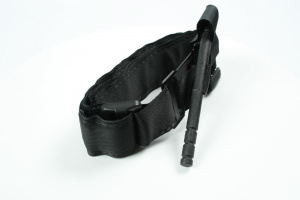Tourniquet (extremity)
Background
- Tourniquets have been used in military dating back to the Roman army although the term was not coined until 1718.
- In the US military, tourniquets were issued to soldiers from the time of the American Civil War up till World War I. However, tourniquets fell out of favor during World War II.
- During WWI four recommendations regarding the use of tourniquets were given. 1) Never cover a tourniquet 2) Write that a tourniquet was applied on the medical tag 3) If conscious tell the service member to verbally inform medical providers that a tourniquet was applied 4) Leave a tourniquet in place for up to 6 hours only
- During the Vietnam conflict, 2500 US casualties were noted to have perished because of hemorrhaging from an extremity wound alone that is no other significant injuries were noted on the casualty.
- Based on experience from use over the last decade, tourniquets have been shown to be safe and life-saving. The reason tourniquets fell out of favor with the US military was due to poor patient transport out of no man's land in WWI which lead to ischemic complications.
- Extremity hemorrhage is the most frequent cause of preventable battlefield deaths thus early control of severe hemorrhage is critical.
- Tourniquets are a proven effective means of controlling extremity hemorrhage [1]
- Damage to extremity is rare if tourniquet is left on for < 2 hours (recall that TQ are frequently used in surgeries which last several hours). This risk of damage to the limb is considered acceptably small rather than having the casualty expire due to exsanguination.
Indications
- Severe extremity hemorrhage, not able to be rapidly controlled by other means
Contraindications
- None
Properties of a Good Tourniquet (Military Use)
- When tightened, eliminates arterial blood flow completely (as evidenced by doppler)
- Easily released and re-applied
- Can be applied to self one-handed
- Application time <60s
- Simple application that requires minimal familiarization
- Can be used in dark, cold, hot, wet, sandy, muddy, icy environments equally well
- No assembly required, no batteries needed
- Shelf life for 10 years or longer
- Width > 1"
- Size should be such that it can fit circumferentially around the thigh of 95% of service members (26.7 cm)
- Weight should be < 8 oz. (250 g)
Application of Tourniquet
- Place as soon as possible, ideally prior to onset of shock
- Remove clothing so that TQ can be applied directly to skin and remain in full view
- Apply 2-3 inches above wound
- Tighten until bleeding is controlled and distal pulse is eliminated
- Document time of placement on medical tag -- consider writing time of placement on patient with indelible marker
- If bleeding is not controlled and distal pulse not eliminated with first TQ:
- Apply 2nd tourniquet just proximal to the first
- Increasing the tourniquet WIDTH with a second TQ controls bleeding more effectively and reduces complications versus over-tightening initial TQ.
- Analgesia as needed after placement
Precautions
- Do not apply directly over joint or impaled object
- Do not periodically loosen
- Observe for bleeding as patient is resuscitated and blood pressure increases
- Do Not Remove TQ if:
- Definitive treatment to be initiated within 2 hours after time of application
- The extremity distal to the tourniquet has been traumatically amputated
- Patient is in shock
- The tourniquet has already been on for more than 6 hours
Proper Removal at Medical Treatment Facility
- Place pressure dressing over wound
- Loosen TQ slowly observe for bleeding
- If bleeding controlled, then leave TQ loosely in place in case of recurrent bleeding
- If bleeding is not controlled without the TQ then re-tighten it
See Also
External Links
Videos
{{#widget:YouTube|id=pFABs0O6-Qk}}
References
- ↑ Smith AA. et al. Prehospital tourniquet use in penetrating extremity trauma: Decreased blood transfusions and limb complications. J Trauma Acute Care Surg. 2019;86(1):43-51.



